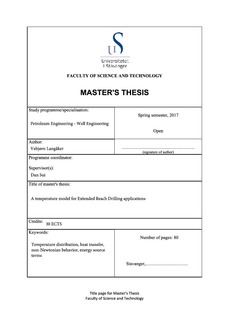| dc.contributor.advisor | Sui, Dan | |
| dc.contributor.author | Langåker, Vebjørn | |
| dc.date.accessioned | 2017-10-26T13:16:16Z | |
| dc.date.available | 2017-10-26T13:16:16Z | |
| dc.date.issued | 2017-06-15 | |
| dc.identifier.uri | http://hdl.handle.net/11250/2462405 | |
| dc.description | Master's thesis in Petroleum engineering | nb_NO |
| dc.description.abstract | Ensuring precise estimation of temperature is a critical process for well planning and real-time drilling operations, especially for Extended Reach Drilling (ERD). Therefore, a temperature model has been developed to predict accurate wellbore temperature distributions for ERD applications. The model offers improvements to existing circulating temperature models in terms of more realistic drilling fluid properties and by introducing effects of heat sources that occurs in a drilling operation.
In this work, temperature dependent drilling fluid transport and thermal properties are considered to improve the accuracy of the temperature model. Experiments have been performed to determine the behavior of drilling fluid density and viscosity under high pressure and high temperature conditions. Measurements of viscosity allows the effect of non-Newtonian behavior to be included in the convective heat transfer processes. Furthermore, applying a non-Newtonian pressure loss model enables an opportunity to incorporate the impact of non-Newtonian behavior on the wellbore pressure distribution and thus pressure dependent drilling fluid properties. Another important aspect of the approach in this work, is the introduction of heat source terms. Heat generation that occurs during drilling processes have the potential to affect the wellbore temperature distribution. To give a better estimation of wellbore heat transfer processes, heat generation due to drill pipe rotation, drill bit friction, frictional pressure losses, and the Joule-Thomson coefficient is considered.
Results from a sensitivity analysis indicate that parameters related to the hydraulics of a wellbore system have a significant effect on the temperature distribution. The flow rate is found to be a major contributor. Drilling fluid viscosity, density, and specific heat capacity have also shown significant effect on the temperature distribution. On the other hand, mechanical processes and heat generation due to friction are found to be less dominant. Results verify that the approach in this thesis provides an accurate wellbore temperature distribution with the possibility to enhance drilling performance and optimize well design. | nb_NO |
| dc.language.iso | eng | nb_NO |
| dc.publisher | University of Stavanger, Norway | nb_NO |
| dc.relation.ispartofseries | Masteroppgave/UIS-TN-IPT/2017; | |
| dc.rights | Navngivelse 4.0 Internasjonal | * |
| dc.rights.uri | http://creativecommons.org/licenses/by/4.0/deed.no | * |
| dc.subject | petroleumsteknologi | nb_NO |
| dc.subject | petroleum engineering | nb_NO |
| dc.subject | well engineering | nb_NO |
| dc.subject | brønnteknologi | nb_NO |
| dc.title | A temperature model for Extended Reach Drilling applications | nb_NO |
| dc.type | Master thesis | nb_NO |
| dc.subject.nsi | VDP::Technology: 500::Rock and petroleum disciplines: 510::Petroleum engineering: 512 | nb_NO |

